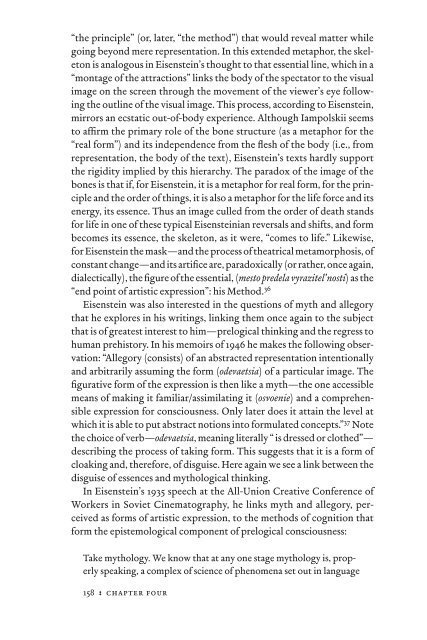In Excess: Sergei Eisentein's Mexico - Cineclub
In Excess: Sergei Eisentein's Mexico - Cineclub
In Excess: Sergei Eisentein's Mexico - Cineclub
Create successful ePaper yourself
Turn your PDF publications into a flip-book with our unique Google optimized e-Paper software.
“the principle” (or, later, “the method”) that would reveal matter while<br />
going beyond mere representation. <strong>In</strong> this extended metaphor, the skeleton<br />
is analogous in Eisenstein’s thought to that essential line, which in a<br />
“montage of the attractions” links the body of the spectator to the visual<br />
image on the screen through the movement of the viewer’s eye following<br />
the outline of the visual image. This process, according to Eisenstein,<br />
mirrors an ecstatic out-of-body experience. Although Iampolskii seems<br />
to affi rm the primary role of the bone structure (as a metaphor for the<br />
“real form”) and its independence from the fl esh of the body (i.e., from<br />
representation, the body of the text), Eisenstein’s texts hardly support<br />
the rigidity implied by this hierarchy. The paradox of the image of the<br />
bones is that if, for Eisenstein, it is a metaphor for real form, for the principle<br />
and the order of things, it is also a metaphor for the life force and its<br />
energy, its essence. Thus an image culled from the order of death stands<br />
for life in one of these typical Eisensteinian reversals and shifts, and form<br />
becomes its essence, the skeleton, as it were, “comes to life.” Likewise,<br />
for Eisenstein the mask—and the process of theatrical metamorphosis, of<br />
constant change—and its artifi ce are, paradoxically (or rather, once again,<br />
dialectically), the fi gure of the essential, (mesto predela vyrazitel’nosti) as the<br />
“end point of artistic expression”: his Method. 36<br />
Eisenstein was also interested in the questions of myth and allegory<br />
that he explores in his writings, linking them once again to the subject<br />
that is of greatest interest to him—prelogical thinking and the regress to<br />
human prehistory. <strong>In</strong> his memoirs of 1946 he makes the following observation:<br />
“Allegory (consists) of an abstracted representation intentionally<br />
and arbitrarily assuming the form (odevaetsia) of a particular image. The<br />
fi gurative form of the expression is then like a myth—the one accessible<br />
means of making it familiar/assimilating it (osvoenie) and a comprehensible<br />
expression for consciousness. Only later does it attain the level at<br />
which it is able to put abstract notions into formulated concepts.” 37 Note<br />
the choice of verb—odevaetsia, meaning literally “ is dressed or clothed”—<br />
describing the process of taking form. This suggests that it is a form of<br />
cloaking and, therefore, of disguise. Here again we see a link between the<br />
disguise of essences and mythological thinking.<br />
<strong>In</strong> Eisenstein’s 1935 speech at the All-Union Creative Conference of<br />
Workers in Soviet Cinematography, he links myth and allegory, perceived<br />
as forms of artistic expression, to the methods of cognition that<br />
form the epistemological component of prelogical consciousness:<br />
Take mythology. We know that at any one stage mythology is, properly<br />
speaking, a complex of science of phenomena set out in language<br />
158 : chapter four


